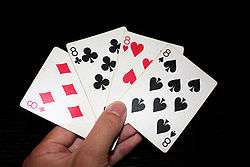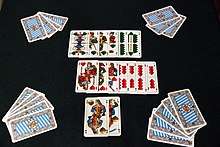Crazy Eights
Crazy Eights is a shedding-type card game for two to seven players. The object of the game is to be the first player to discard all of his or her cards. The game is similar to Switch and Mau Mau.[1]
 In Crazy Eights, playing an 8 card will change the current suit of the game. | |
| Type | Shedding |
|---|---|
| Players | 2+ |
| Skills required | Tactics and communication |
| Cards | 52 |
| Deck | French |
| Play | Clockwise and counter-clockwise |
| Playing time | Various |
| Random chance | Medium |
| Related games | |
| Mau Mau, Uno | |
A standard 52-card deck is used when there are five or fewer players. When there are more than five players, two decks are shuffled together and all 104 cards are used.
Origins
The game first appeared as Eights in the 1930s,[1] and the name Crazy Eights dates to the 1940s, derived from the United States military designation for discharge of mentally unstable soldiers, Section 8.[2][3]
There are many variations of the basic game, and a number of different names including Craits, Last One, Mau-Mau, Pesten, Rockaway, Swedish Rummy, Switch, Last Card, Screw Your Neighbor, Püskiyon, and Tschausepp. Bartok, Mao, Quango, Zar, Taki, and Uno are more extreme variations.
David Parlett describes Crazy Eights as "not so much a game as a basic pattern of play on which a wide variety of changes can be rung," noting that players can easily invent and explore new rules.[1]
Basic play
Five cards are dealt to each player (or seven in a two-player game).[4] The remaining cards of the deck are placed face down at the center of the table. The top card is then turned face up to start the game.
Players discard by matching rank or suit with the top card of the discard pile, starting with the player left of the dealer. They can also play any 8 at any time, which allows them to declare the suit that the next player is to play; that player must then follow the named suit or play another 8. If a player is unable or unwilling to play a card, they must repeatedly draw cards from the stockpile until they draw a card they are able and willing to play, and play it.[1]
As an example: Once 6♣ is played the next player:
- can play 6♦, 6♥ or 6♠
- can play any club
- can play any 8 (then must declare a suit)
- can draw from the stockpile and continue their turn
If the stock pile runs out, all played cards except for the top one are reshuffled to form a new stock.[4]
The game ends as soon as one player has emptied their hand. That player collects a payment from each opponent equal to the point score of the cards remaining in that opponent's hand. 8s score 50, court cards 10 and all other cards face value. If the players run out of cards in the deck, the player with the lowest point score in their hand scores the difference between that hand and each opponent's hand.[1]
The winner of the game is the first player to reach a specific number of points. For two players it is 100 points, three players 150, four 200, five 250, six 300 and for seven players 350.
Variations
Card game historian John McLeod describes Crazy Eights as "one of the easiest games to modify by adding variations",[4] and many variant rules exist. Common rules applied to cards include:
- Queens skip
- Playing a Queen causes the next player to miss their turn.[4]
- Aces reverse direction
- Playing an Ace reverses the direction of play.[4]
- Draw 2
- Playing a two forces the next player to draw two cards, unless they can play another two. Multiple twos "stack"; if a two is played in response to a two, the next player must draw four.[4]
A popular variant of the game in the United States is Crazy Eights Countdown, where players starts with a score of 8. A player's score determines how many cards they are dealt at the start of each round, and which rank of card is wild for them. (So initially, all players are dealt eight cards and 8s are wild for everyone; after one round, one player will be dealt seven cards and 7s will be wild for them, but 8s will be wild for everyone else.) The first player to reduce their score to zero wins the game.[4]
See also
- Uno (card game)
- Switch (card game)
- Mau Mau (card game)
- Macau (card game)
- Taki (card game)
References
- Parlett, David (1996). Oxford Dictionary of Card Games. Oxford University Press. p. 291. ISBN 0-19-869173-4.
- Rauf, Don (2013). Simple rules for card games : instructions and strategy for twenty card games (1st ed.). New York: Potter Style. p. 25. ISBN 978-0-7704-3385-7.
- Rome, Ben H.; Hussey, Chris (2013). Games' most wanted : the top 10 book of players, pawns, and power-ups (1st ed.). University of Nebraska Press. ISBN 978-1-59797-723-4.
- https://www.pagat.com/eights/crazy8s.html
